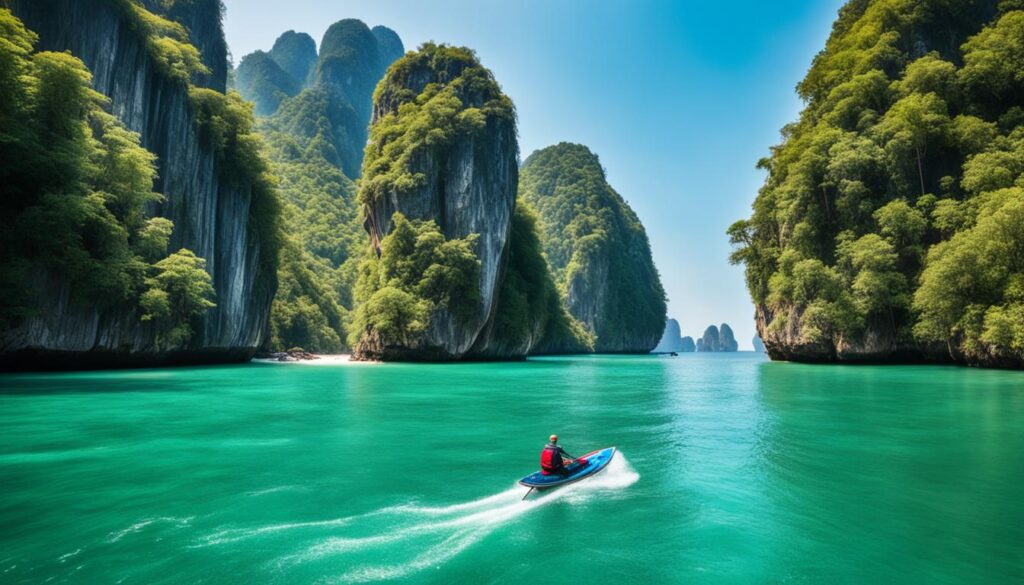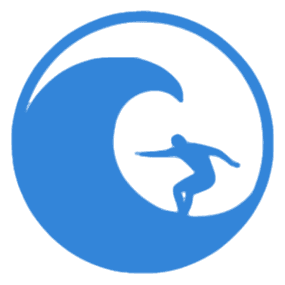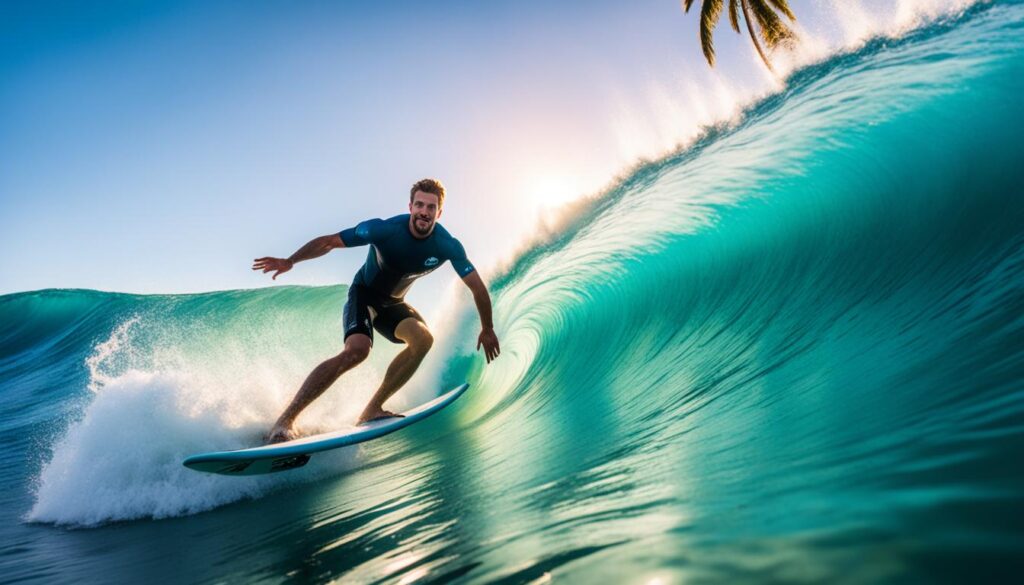Did you know that Thailand’s surf industry has grown by over 300% in the past decade, attracting both budding and professional surfers from around the world? This once-sleepy Southeast Asian nation has quietly emerged as a thrilling new destination for wave chasers, offering a diverse array of surf spots that cater to surfers of all skill levels.
Thailand’s coastline, split between the Andaman Sea on the west and the Gulf of Thailand on the east, provides a unique surfing experience unlike anywhere else. While the country’s beaches were once known more for their stunning beauty than their waves, Thailand has now firmly established itself as an up-and-coming surf haven, with a variety of spots that promise an unforgettable adventure. From the surf capital of Phuket to the laid-back waves of Khao Lak and the uncrowded southern breaks of Koh Lanta, Thailand’s surfing landscape is as diverse as the tropical landscapes that frame it.
Key Takeaways
- Thailand has become a thriving surf destination, with a 300% growth in the industry over the past decade.
- The country’s coastlines on the Andaman Sea and Gulf of Thailand offer diverse surfing experiences.
- Top surf spots include the surf capital of Phuket, the laid-back waves of Khao Lak, and the uncrowded southern breaks of Koh Lanta.
- Thailand’s surf scene caters to surfers of all skill levels, from beginners to professionals.
- Surfing in Thailand is set against the backdrop of stunning tropical landscapes.
Introduction to Wave Surfing in Thailand
Surfing in Thailand wasn’t popular until the 1990s, but the country has since slowly gained recognition as a fantastic destination for both beginner and experienced surfers. Thailand’s emerging surf culture has been fueled by the country’s diverse coastlines, which offer a wide range of wave conditions and surf spots. While the popular tourist islands like Koh Samui and Koh Phangan were once known for their flat, calm waters, the Andaman Sea side of the mainland has become a hub for surfers seeking out uncrowded waves and tropical adventures.
Thailand’s Emerging Surf Culture
As Thailand’s surf scene has grown, new surf camps, schools, and competitions have sprung up, allowing visitors to immerse themselves in the local surfing community and discover hidden gems along the coast.
Discovering the Hidden Gems
While the popular tourist destinations may have been known for their calm waters, the Andaman Sea side of Thailand has become a hub for surfers seeking out uncrowded waves and unique surfing destinations. As the best surfing spots in Thailand continue to be explored, visitors can look forward to discovering the country’s hidden gems and experiencing the vibrant surf culture firsthand.
wave surfing thailand: Top Destinations
Thailand’s diverse coastlines offer a wealth of destinations for surfers seeking unforgettable wave riding experiences. From the renowned surf capital of Phuket to the laid-back paradise of Khao Lak and the uncrowded southern breaks of Koh Lanta, each location provides a unique surfing adventure set against the backdrop of Thailand’s stunning tropical landscapes.
Phuket: The Surf Capital of Thailand
Phuket is widely considered the surf capital of Thailand, offering a variety of surf spots facing different directions and world-class facilities. Beaches like Bangtao, Surin, Kamala, Kata, and Patong cater to surfers of all levels, with waves ranging from 1 to 3 meters in height. Whether you’re a beginner looking to learn the basics or an experienced surfer seeking challenging waves, Phuket’s diverse surf destinations provide the perfect canvas for your surfing adventure.
Khao Lak: Laid-Back Surfing Paradise
Khao Lak, located north of Phuket, has become a popular destination for longboarders seeking a more laid-back surfing experience. The mellow waves and relaxed atmosphere of Memories Beach make it an ideal spot for surfers looking to unwind and soak up the tropical ambiance. With its stunning natural surroundings and serene vibe, Khao Lak offers a refreshing alternative to the busier surf spots in the region.
Koh Lanta: Uncrowded Southern Waves
Further south, the island of Koh Lanta provides an off-the-beaten-path surfing experience for intermediate to advanced surfers. With uncrowded spots and great waves during the monsoon season, Koh Lanta has emerged as a secret gem for those seeking an authentic, uncrowded surfing adventure in Thailand. The island’s rugged natural beauty and laid-back vibe complement the thrilling surf conditions, making it a must-visit destination for the discerning wave rider.
Surf Spots for All Levels
Thailand’s diverse coastline offers surf spots that cater to surfers of every skill level, ensuring that there’s something to meet the needs of both beginners and experienced wave riders. From the gentle, beginner-friendly beaches to the challenging, advanced surf breaks, Thailand’s surfing destinations provide a well-rounded experience for surfers of all abilities.
Beginner-Friendly Beaches
For those new to the sport, Thailand’s beginner-friendly beaches, such as Patong, Kata Noi, and Chaweng, offer the perfect introduction to wave surfing. These locations feature short, manageable waves that are ideal for learning the fundamentals and building confidence on the board. The calm, consistent conditions make them excellent choices for surf lessons and practicing essential techniques.
Intermediate Surf Breaks
As surfers progress in their skills, Thailand’s intermediate surf spots, including Bang Tao, Surin, and Kamala, provide the next level of challenge. These locations offer larger waves, often with features like reef breaks, that test the abilities of more experienced surfers. The varied wave conditions and reliable swell patterns make these spots popular among intermediate-level riders looking to take their surfing to the next level.
Challenging Waves for Advanced Surfers
For the seasoned surfers seeking a true adrenaline rush, Thailand has a selection of spots known for their powerful, fast-breaking waves. Locations like Pansea, Kalim, Nai Harn, and the northern end of Kamala Beach offer the kind of challenging conditions that advanced surfers crave. These breaks test the skills and nerve of even the most skilled wave riders, providing an unparalleled surfing experience set against Thailand’s stunning tropical backdrop.
Surfing Seasons and Conditions
The best time to embark on a surf travel thailand adventure is largely dictated by the monsoon winds that influence the country’s coastal regions. The west coast, home to popular surf spots like Phuket and Khao Lak, sees ideal surfing seasons thailand from April to October, when the southwest monsoon brings consistent swell.
On the east coast, where the picturesque island of Koh Lanta is located, the wave surfing thailand season peaks from October to December, under the influence of the northeast monsoon. During these prime months, wave heights can vary significantly, with the west coast offering larger, more powerful waves (1-3 meters) and the east coast presenting more manageable swells (0.5-2 meters).
Regardless of the coast, the warm water temperatures (28°C to 30°C) allow for comfortable, wetsuit-free surfing throughout the year, making Thailand an attractive destination for surf travel thailand enthusiasts seeking to catch waves in a tropical paradise.
Understanding Monsoon Patterns
The monsoon winds that shape Thailand’s surf seasons play a crucial role in determining the quality and consistency of the waves. Understanding these seasonal patterns is key to planning the perfect surf trip and maximizing your time in the water.
Wave Heights and Quality
Wave heights and quality can vary significantly between the west and east coasts of Thailand, offering diverse surfing experiences for surfers of all skill levels. The west coast, home to larger, more powerful waves, caters to intermediate and advanced surfers, while the east coast’s more manageable swells provide excellent learning opportunities for beginners.
Surf Culture and Etiquette
Surfing in Thailand is not just about catching waves – it’s about embracing the local surf culture and surf etiquette. As part of the surfing communities in Thailand, it’s crucial to respect the lineup and communicate effectively with fellow surfers to maintain harmony on the water.
Respecting the Lineup
In the lineup, surfers must respect the right-of-way, allowing the rider closest to the peak of the wave to have priority. Taking turns and avoiding dropping in on others helps preserve the camaraderie and sportsmanship that define the surf culture in Thailand. Patience and consideration for your fellow surfers will go a long way in ensuring everyone enjoys their time in the water.
Communicating in the Water
Clear communication is essential for a safe and enjoyable surfing experience. Simple nods, shouts, or hand signals can help surfers avoid collisions and ensure everyone gets their fair share of waves. By immersing themselves in the local surf etiquette, visitors can forge meaningful connections with Thai surfers and truly experience the laid-back, welcoming spirit that characterizes Thailand’s vibrant surfing communities.
Surf Gear and Rentals
Thailand’s surf spots are well-equipped to cater to surfers of all levels, with a variety of
surf gear
available for rent or purchase. Beginner and intermediate surfers can find
longboards
and
softboards
at reasonable daily rates, often ranging from $10 to $20 USD. More experienced surfers can rent
shortboards
to tackle the larger waves.
Board Options for Every Level
Wetsuit rentals, while rarely needed due to the warm water temperatures, are also available for around $10 USD per day. Many of the popular surf spots, especially on the west coast, have dedicated surf shops that not only rent out equipment but also offer surf lessons from local experts. Engaging with these local businesses and tapping into their knowledge can help surfers make the most of their time in the water.
Local Surf Shops and Rental Prices
Surfers visiting Thailand can find a wide range of surf rentals at local shops and surf camps. The following table provides a general overview of typical rental prices for various surf gear:
| Gear Type | Rental Price (per day) |
|---|---|
| Longboard | $10 – $20 USD |
| Softboard | $10 – $20 USD |
| Shortboard | $15 – $30 USD |
| Wetsuit | $10 USD |
By taking advantage of these rental options, surfers of all skill levels can enjoy the best surf gear thailand has to offer, without the need to transport their own equipment.
Surf Lessons and Camps
For those new to surfing or looking to improve their skills, Thailand offers a wealth of opportunities to learn from local experts. Surf schools and camps can be found at many of the country’s top surf spots, providing instruction tailored to different skill levels. Beginner surfers can start on the gentle, forgiving waves of the east coast, while more advanced riders can hone their techniques under the guidance of experienced coaches.
Learning from Local Experts
Thailand’s surf lessons and camps are led by knowledgeable local instructors who are passionate about sharing their love of the sport. Whether you’re a complete novice or an intermediate surfer, these experts can provide personalized guidance to help you develop proper technique, read the waves, and build your confidence in the water.
Immersive Surf Camp Experiences
Beyond just lessons, some surf camps in Thailand offer immersive experiences, allowing visitors to fully immerse themselves in the local surfing communities and culture. These holistic programs go beyond just teaching the fundamentals of surfing, providing opportunities to explore the surrounding areas, connect with fellow surf enthusiasts, and gain a deeper appreciation for the unique charm of surfing in Thailand.
Surfing Events and Competitions
As Thailand’s surfing community continues to grow, the country has also become a hub for surfing events and competitions. The annual Phuket Surfing Contest, held at the iconic Kata Beach, is one of the most prominent events, attracting surfers from around the world to compete for a cash prize of over $3,000. Other local competitions, such as the Kamala Go Surfing Challenge, also provide opportunities for both professional and amateur surfers to showcase their skills and be a part of the vibrant Thai surfing community.
These events not only celebrate the sport but also serve as a means for surfers to connect with each other and immerse themselves in the unique culture and atmosphere that defines surfing in Thailand. By participating in or attending these competitions, visitors can truly experience the passion and camaraderie that drives the country’s thriving surfing scene.
| Event | Location | Prize |
|---|---|---|
| Phuket Surfing Contest | Kata Beach, Phuket | Over $3,000 |
| Kamala Go Surfing Challenge | Kamala Beach, Phuket | Cash prizes |
Surf Travel and Accommodation
Planning a surf trip to Thailand goes beyond just catching waves – it’s about finding the right accommodations to complement your surfing experience. Many resorts and hostels along the country’s surf spots cater specifically to the needs of surfers, offering amenities like board storage, surf transfer services, and easy access to the best breaks.
Surf-Friendly Resorts and Hostels
When booking your surf travel thailand adventure, consider the proximity to your preferred surf spots, as well as the availability of surf camps thailand or surf-focused activities. By choosing the right lodging, you can ensure a seamless and enjoyable surf vacation in Thailand.
Planning Your Surf Trip
Many surfing resorts thailand offer specialized packages and services tailored to surfers, from providing board storage to arranging surf transportation and lessons. Doing your research and planning your itinerary carefully can help you maximize your time in the water and immerse yourself in the vibrant surf culture that defines Thailand’s coastal regions.

Surfing Communities in Thailand
Surfing in Thailand is more than just a sport – it’s a tight-knit community that embraces the laid-back, friendly spirit of the country. As you explore the various surf spots, take the time to connect with local surfers, who are often eager to share their knowledge, favorite breaks, and insights into the unique surf culture.
Connecting with Local Surfers
Striking up conversations with Thai surfers at the lineup or in the local surf shops can be a rewarding experience. These passionate individuals are eager to help newcomers navigate the best waves and immerse themselves in the surfing communities that define each coastal town. By forging these connections, you’ll not only improve your surfing skills but also gain a deeper appreciation for the camaraderie and shared love of the sport that binds the Thai surfing community together.
Surf Clubs and Organizations
Many of Thailand’s coastal towns are home to dedicated surf clubs and organizations that work to preserve the local surfing communities and surf culture. These groups often host events, coordinate beach cleanups, and advocate for sustainable practices to ensure the longevity of the sport. By engaging with these clubs, you can immerse yourself in the social fabric of the surfing scene and contribute to the collective efforts to protect the natural environments that make Thailand’s surf spots so special.

